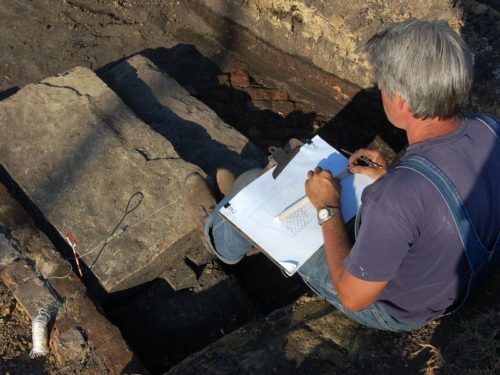In Land of Lincoln, Long-Buried Traces of a Race Riot Come to the Surface
Share
Explore Our Galleries
Breaking News!
Today's news and culture by Black and other reporters in the Black and mainstream media.
Ways to Support ABHM?
Archaeologists recently uncovered the remains of five houses that lay witness to the tragedy that set Springfield, Illinois, on fire in 1908

House A” excavation detail (Fever River Research, Springfield, Illinois)
By Megan Gannon, SMITHSONIAN.COM
Recently, archaeologists uncovered the remains of five houses that once stood in a historically black neighborhood in Springfield, Illinois, until they were burned in a race riot 110 years ago. The carcasses of the structures are the last remaining witnesses to the lie that one Mabel Hallam told on a Thursday night in August of 1908 that set the hometown of Abraham Lincoln, “The Great Emancipator,” aflame.
A married white woman, Hallam claimed that summer she had been raped in her home by an unknown black man. The next morning, police searched for her alleged assailant, picking up black laborers who had been in her white working-class neighborhood. Hallam pointed to a brick carrier named George Richardson, identifying him as her rapist. Richardson was subsequently jailed alongside Joe James, another black man, who had been accused in July, on shaky circumstantial evidence, of fatally stabbing a white man during a break-in. By the afternoon, a white mob gathered outside the jail. Talk of a lynching spread.
Lynchings are most often associated with the Jim Crow-era South. The Equal Justice Initiative—the non-profit that opened the first U.S. monument to victims of lynching in Montgomery, Alabama, earlier this year— has documented 4,084 racial terror lynchings in 12 Southern states between 1877 and 1950. But EJI has also identified about 300 lynchings in other states during the same period. Such an event was not unheard of in Illinois, which had passed anti-lynching legislation in 1905 to prevent mob violence against African-Americans. And, as in the South, rape allegations like Hallam’s were among the most common catalysts for a lynching. Those accusations could also serve as the pretense for violence directed at black communities in general…
Read full article here
More information here
More Breaking News here
View more galleries from the ABHM here









Comments Are Welcome
Note: We moderate submissions in order to create a space for meaningful dialogue, a space where museum visitors – adults and youth –– can exchange informed, thoughtful, and relevant comments that add value to our exhibits.
Racial slurs, personal attacks, obscenity, profanity, and SHOUTING do not meet the above standard. Such comments are posted in the exhibit Hateful Speech. Commercial promotions, impersonations, and incoherent comments likewise fail to meet our goals, so will not be posted. Submissions longer than 120 words will be shortened.
See our full Comments Policy here.